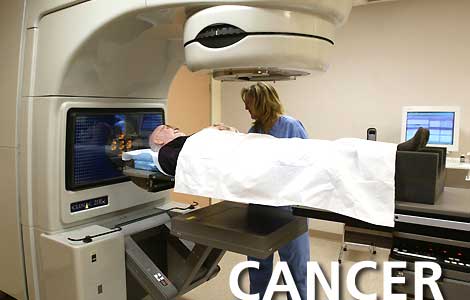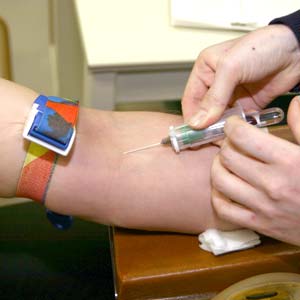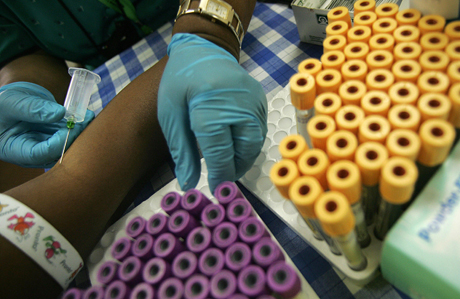Prostate-specific antigen (PSA) is a protein produced by cells of the prostate gland. The PSA test measures the level of PSA in the blood. The doctor takes a blood sample, and the amount of PSA is measured in a laboratory. Because PSA is produced by the body and can be used to detect disease, it is sometimes called a biological marker or a tumor marker.
It is normal for men to have a low level of PSA in their blood; however, prostate cancer or benign (not cancerous) conditions can increase a man’s PSA level. As men age, both benign prostate conditions and prostate cancer become more common. The most frequent benign prostate conditions are prostatitis (inflammation of the prostate) and benign prostatic hyperplasia (BPH) (enlargement of the prostate). There is no evidence that prostatitis or BPH causes cancer, but it is possible for a man to have one or both of these conditions and to develop prostate cancer as well.

A man’s PSA level alone does not give doctors enough information to distinguish between benign prostate conditions and cancer. However, the doctor will take the result of the PSA test into account when deciding whether to check further for signs of prostate cancer.
Why is the PSA test performed?
The U.S. Food and Drug Administration (FDA) has approved the use of the PSA test along with a digital rectal exam (DRE) to help detect prostate cancer in men 50 years of age or older. During a DRE, a doctor inserts a gloved finger into the rectum and feels the prostate gland through the rectal wall to check for bumps or abnormal areas. Doctors often use the PSA test and DRE as prostate cancer screening tests; together, these tests can help doctors detect prostate cancer in men who have no symptoms of the disease.
The FDA has also approved the use of the PSA test to monitor patients who have a history of prostate cancer to see if the cancer has recurred (come back). If a man’s PSA level begins to rise, it may be the first sign of recurrence. Such a “biochemical relapse” typically precedes clinical signs and symptoms of a relapse by months or years. However, a single elevated PSA measurement in a patient with a history of prostate cancer does not always mean the cancer has come back. A man who has been treated for prostate cancer should discuss an elevated PSA level with his doctor. The doctor may recommend repeating the PSA test or performing other tests to check for evidence of a recurrence. The doctor may look for a trend of rising PSA measurements over time rather than a single elevated PSA level.

It is important to note that a man who is receiving hormone therapy for prostate cancer may have a low PSA level during, or immediately after, treatment. The low level may not be a true measure of the man’s PSA level. Men receiving hormone therapy should talk with their doctor, who may advise them to wait a few months after hormone treatment before having a PSA test.
For whom might a PSA screening test be recommended?
Doctors’ recommendations for screening vary. Some encourage yearly screening for men over age 50, and some advise men who are at a higher risk for prostate cancer to begin screening at age 40 or 45. Others caution against routine screening. Although specific recommendations regarding PSA screening vary, there is general agreement that men should be informed about the potential risks and benefits of PSA screening before being tested. Currently, Medicare provides coverage for an annual PSA test for all men age 50 and older.
Several risk factors increase a man’s chances of developing prostate cancer. These factors may be taken into consideration when a doctor recommends screening. Age is the most common risk factor, with nearly 63 percent of prostate cancer cases occurring in men age 65 and older (1). Other risk factors for prostate cancer include family history, race, and possibly diet. Men who have a father or brother with prostate cancer have a greater chance of developing prostate cancer. African American men have the highest rate of prostate cancer, while Asian and Native American men have the lowest rates. In addition, there is some evidence that a diet higher in fat, especially animal fat, may increase the risk of prostate cancer.
How are PSA test results reported?
PSA test results show the level of PSA detected in the blood. These results are usually reported as nanograms of PSA per milliliter (ng/mL) of blood. In the past, most doctors considered a PSA level below 4.0 ng/mL as normal. In one large study, however, prostate cancer was diagnosed in 15.2 percent of men with a PSA level at or below 4.0 ng/mL (2). Fifteen percent of these men, or approximately 2.3 percent overall, had high-grade cancers (2). In another study, 25 to 35 percent of men who had a PSA level between 4.1 and 9.9 ng/mL and who underwent a prostate biopsy were found to have prostate cancer, meaning that 65 to 75 percent of the remaining men did not have prostate cancer (3).

Thus, there is no specific normal or abnormal PSA level. In addition, various factors, such as inflammation (e.g., prostatitis), can cause a man’s PSA level to fluctuate. It is also common for PSA values to vary somewhat from laboratory to laboratory. Consequently, one abnormal PSA test result does not necessarily indicate the need for a prostate biopsy. In general, however, the higher a man’s PSA level, the more likely it is that cancer is present. Furthermore, if a man’s PSA level continues to rise over time, other tests may be needed.
Because PSA levels tend to increase with age, the use of age-specific PSA reference ranges has been suggested as a way of increasing the accuracy of PSA tests. However, age-specific reference ranges have not been generally favored because their use may lead to missing or delaying the detection of prostate cancer in as many as 20 percent of men in their 60s and 60 percent of men in their 70s. Another complicating factor is that studies to establish the normal range of PSA values have been conducted primarily in white men. Although expert opinions vary, there is no clear consensus on the optimal PSA threshold for recommending a prostate biopsy for men of any racial or ethnic group.
# What if the screening test results show an elevated PSA level?
A man should discuss an elevated PSA test result with his doctor. There can be different reasons for an elevated PSA level, including prostate cancer, benign prostate enlargement, inflammation, infection, age, and race.
If no symptoms to suggest cancer are present, the doctor may recommend repeating DRE and PSA tests regularly to watch for any changes. If a man’s PSA level has been increasing or if a suspicious lump is detected during a DRE, the doctor may recommend other tests to determine if there is cancer or another problem in the prostate. A urine test may be used to detect a urinary tract infection or blood in the urine. The doctor may recommend imaging tests, such as a transrectal ultrasound (a test in which high-frequency sound waves are used to obtain images of the rectum and nearby structures, including the prostate), x-rays, or cystoscopy (a procedure in which a doctor looks into the urethra and the bladder through a thin, lighted tube that is inserted through the end of the penis; this can help determine whether urinary blockage is caused by an enlarged prostate). Medicine or surgery may be recommended if the problem is BPH or an infection.
If cancer is suspected, a biopsy is needed to determine whether cancer is present in the prostate. During a biopsy, samples of prostate tissue are removed, usually with a needle, and viewed under a microscope. The doctor may use ultrasound to view the prostate during the biopsy, but ultrasound cannot be used alone to tell if cancer is present.
What if the test results show a rising PSA level after treatment for prostate cancer?
A man should discuss rising PSA test results with his doctor. Doctors consider a number of factors before recommending further treatment. Additional treatment based on a single PSA test result is often not recommended. Rather, a rising trend in PSA test results over a period of time combined with other findings, such as an abnormal DRE, positive prostate biopsy results, or abnormal CT (computed tomography) scan results, may lead to a recommendation for further treatment.

According to the National Comprehensive Cancer Network (NCCN) Clinical Practice Guidelines in Oncology for Prostate Cancer (4), additional treatment may be indicated based on the following PSA test results:
* For men who have been in the watchful waiting phase—their PSA level has doubled in fewer than 3 years or they have a PSA velocity (change in PSA level over time) of greater than 0.75 ng/mL per year, or they have a prostate biopsy showing evidence of worsening cancer (4).
* For men who have had a radical prostatectomy (removal of the prostate gland)—their PSA level does not fall below the limits of detection after surgery or they have a detectable PSA level (> 0.3 ng/mL) that increases on two or more subsequent measurements after having no detectable PSA (4).
* For men who have had other initial therapy, such as radiation therapy with or without hormonal therapy—their PSA level has risen by 2 ng/mL or more after having no detectable PSA or a very low PSA level (4).
Please note that these are general guidelines. Prostate cancer is a complex disease and many variables need to be considered by each patient and his doctor.
What are some of the limitations of the PSA test?
* Detecting tumors does not always mean saving lives: When used in screening, the PSA test can detect small tumors. However, finding a small tumor does not necessarily reduce a man's chances of dying from prostate cancer. PSA testing may identify very slow-growing tumors that are unlikely to threaten a man's life. Also, PSA testing may not help a man with a fast-growing or aggressive cancer that has already spread to other parts of his body before being detected.
* False-positive tests: False-positive test results (also called false positives) occur when the PSA level is elevated but no cancer is actually present. False positives may lead to additional medical procedures that have potential risks and significant financial costs and can create anxiety for the patient and his family. Most men with an elevated PSA test result turn out not to have cancer; only 25 to 35 percent of men who have a biopsy due to an elevated PSA level actually have prostate cancer (3).
* False-negative tests: False-negative test results (also called false negatives) occur when the PSA level is in the normal range even though prostate cancer is actually present. Most prostate cancers are slow-growing and may exist for decades before they are large enough to cause symptoms. Subsequent PSA tests may indicate a problem before the disease progresses significantly.
Why is the PSA test controversial in screening?
Using the PSA test to screen men for prostate cancer is controversial because it is not yet known for certain whether this test actually saves lives. Moreover, it is not clear that the benefits of PSA screening outweigh the risks of follow-up diagnostic tests and cancer treatments. For example, the PSA test may detect small cancers that would never become life threatening. This situation, called overdiagnosis, puts men at risk of complications from unnecessary treatment.

The procedure used to diagnose prostate cancer (prostate biopsy) may cause harmful side effects, including bleeding and infection. Prostate cancer treatments, such as surgery and radiation therapy, may cause incontinence (inability to control urine flow), erectile dysfunction (erections inadequate for intercourse), and other complications. For these reasons, it is important that the benefits and risks of diagnostic procedures and treatment be taken into account when considering whether to undertake prostate cancer screening.
What research is being done to validate and improve the PSA test?
The benefits of screening for prostate cancer are still being studied. The National Cancer Institute (NCI), a component of the National Institutes of Health, is currently conducting the Prostate, Lung, Colorectal, and Ovarian Cancer Screening Trial, or PLCO trial, to determine whether certain screening tests can help reduce the number of deaths from these cancers. The PSA test and DRE are being evaluated to determine whether yearly screening to detect prostate cancer will decrease a man’s chances of dying from this disease.
Initial results from the trial showed that annual PSA testing for 6 years and annual DRE testing for 4 years (performed in the same years as the first four PSA tests) did not reduce the number of deaths from prostate cancer through a median follow-up period of 11.5 years (range 7.2 to 14.8 years) (5). At 7 years of follow-up, a point in time when follow-up of the participants was essentially complete, 23 percent more cancers had been diagnosed in the screening group than in the control group. In the control group, men were randomly assigned to “usual care.”
These results suggest that many men were diagnosed with, and treated for, cancers that would not have been detected in their lifetime without screening and, as a consequence, were exposed to the potential harms of unnecessary treatments, such as surgery and radiation therapy. Nevertheless, it remains possible that a small benefit from the earlier detection of these “excess” cancers could emerge with longer follow-up. Follow-up of the PLCO participants will continue, therefore, until all participants have been followed for at least 13 years.
In contrast, initial results from another large randomized, controlled trial of prostate cancer screening, called the European Randomized Study of Screening for Prostate Cancer (ERSPC), found a 20 percent reduction in prostate cancer deaths associated with PSA testing every 4 years (6). At the time the results were reported, the participants had been followed for a median of 9 years. The average number of PSA tests per participant in ERSPC was 2.1. Most participating centers in this study used a lower PSA cutoff value as an indicator of abnormality than was used in the PLCO trial (3.0 ng/mL versus 4.0 ng/mL). As in the PLCO trial, many more cancers were diagnosed in the screening group than in the control group. The ERSPC researchers estimated that 1,410 men would have to be screened and 48 additional cancers would have to be detected to prevent one death from prostate cancer (6).

Scientists are also researching ways to improve the PSA test, hopefully to allow cancerous and benign conditions, as well as slow-growing cancers and fast-growing, potentially lethal cancers, to be distinguished from one another. Some of the methods being studied include the following:
* PSA velocity: PSA velocity is the change in PSA level over time. A sharp rise in the PSA level raises the suspicion of cancer and may indicate a fast-growing cancer. A 2006 study found that men who had a PSA velocity above 0.35 ng/mL per year had a higher relative risk of dying from prostate cancer than men who had a PSA velocity less than 0.35 ng/mL per year (7). More studies are needed to determine if a high PSA velocity more accurately detects prostate cancer early.
* PSA density: PSA density considers the relationship between the level of PSA and the size of the prostate. In other words, an elevated PSA level might not arouse suspicion if a man has a very enlarged prostate. The use of PSA density to interpret PSA results is controversial because cancer might be overlooked in a man with an enlarged prostate.
* Free versus attached PSA: PSA circulates in the blood in two forms: Free or attached to a protein molecule. The free PSA test is more often used for men who have higher PSA values. Free PSA may help tell what kind of prostate problem a man has. With benign prostate conditions (such as BPH), there is more free PSA, while cancer produces more of the attached form. If a man’s attached PSA level is high but his free PSA level is not, the presence of cancer is more likely. In this case, more testing, such as a prostate biopsy, may be done. Researchers are exploring additional ways of measuring PSA and comparing these measurements to determine whether cancer is present.
* Alteration of PSA cutoff level: Some researchers have suggested lowering the cutoff levels used to determine whether a PSA measurement is normal or elevated. For example, a number of studies have used cutoff levels of 2.5 or 3.0 ng/mL (rather than 4.0 ng/mL). In such studies, PSA measurements above 2.5 or 3.0 ng/mL are considered elevated. Researchers hope that using these lower cutoff levels will increase the chance of detecting prostate cancer; however, this method may also increase overdiagnosis and false-positive test results and lead to unnecessary medical procedures. (See ERSPC trial results above.)
What other methods are being studied to detect prostate cancer?
Researchers are investigating several other ways to detect prostate cancer that could be used alone or together with the PSA test and DRE. Some of these include the following:
* MicroRNA patterns: MicroRNAs are small, single-strand molecules of ribonucleic acid (RNA) that regulate important cellular functions. Researchers have found that the pattern of microRNAs in a cell can differ depending on the type of cell and between healthy cells and abnormal cells, such as cancer cells. Some research also suggests that the microRNA patterns in early-stage prostate cancer and late-stage prostate cancer may be different.
* Non-mutation gene alterations: The activity of a gene can be altered in ways that do not involve a change (mutation) to its DNA code. This can occur by modifying the gene’s DNA through a process known as methylation or by modifying the proteins that bind to the gene and help control how it is configured in the chromosome on which it is located. These types of gene alterations are called epigenetic alterations. Research has already shown that certain genes become hypermethylated and inactivated during the development and progression of prostate cancer. Scientists hope to identify DNA methylation changes and protein modifications that will be able to identify prostate cancer early and help predict tumor behavior.
* Gene fusions: Sometimes genes on different chromosomes can come together inappropriately and fuse to form hybrid genes. These hybrid genes have been found in several types of cancer, including prostate cancer, and may play a role in cancer development. The gene fusions found in prostate cancer involve members of the ETS family of oncogenes, which are genes that cause cancer when mutated or expressed at higher than normal levels. Researchers are investigating whether diagnostic or prognostic tests based on gene fusions can be developed.
* PCA3: PCA3, also known as DD3, is a prostate-specific RNA that is reported to be expressed at high levels in prostate tumor cells. It does not appear to contain the genetic code for a protein. A urine test for this RNA, to be used in addition to current prostate cancer screening tests, has the potential to be useful and is under study.
* Differential detection of metabolites: Molecules produced by the body’s metabolic processes, or metabolites, may be able to help distinguish between benign prostate tissue, localized prostate cancer, and metastatic prostate cancer. One such molecule, known as sarcosine, has been identified and may be associated with prostate cancer’s invasiveness and aggressiveness. Ongoing research is investigating whether a test based on sarcosine can be developed.

* Proteo-imaging: Proteo-imaging is the ability to localize and follow changes at the molecular level, through imaging, of the protein distributions in specific tissues. Being able to see different patterns of protein expression in healthy prostate tissue versus abnormal prostate tissue may help classify early prostate changes that may one day lead to cancer.
* Protein patterns in the blood: Researchers are also studying patterns of proteins in the blood to see if they can identify one or more unique patterns that indicate the presence of prostate cancer and allow more aggressive cancers to be distinguished from less aggressive ones.

















.jpg)



.jpg)
























